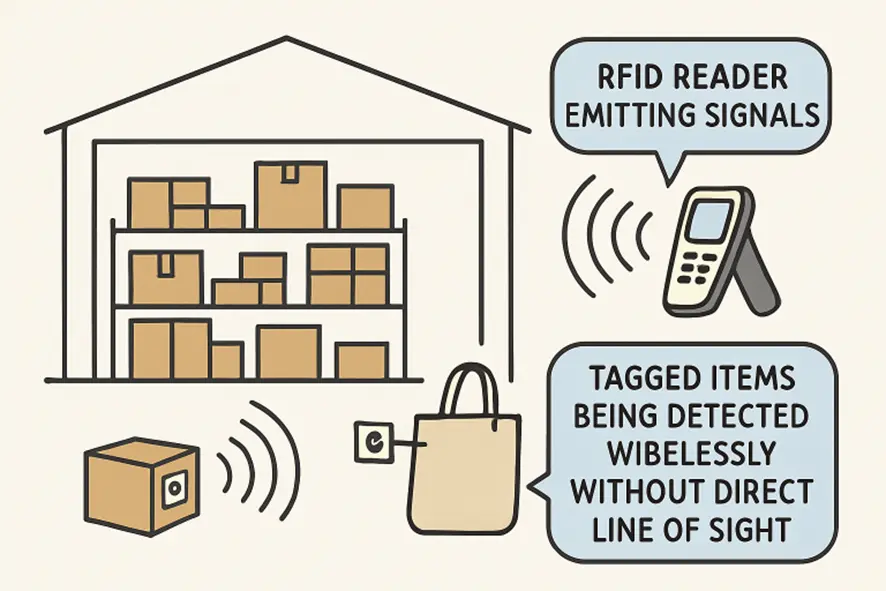What Makes RFID Warehouse Solutions Unique?
In today’s fast-paced logistics landscape, warehouses face mounting pressure to improve accuracy, speed, and efficiency in inventory management. This is where RFID solutions for warehouse environments are distinguishing themselves. Unlike traditional inventory systems that rely on manual entries and line-of-sight barcode scanning, RFID leverages radio frequency identification technology to track assets wirelessly, automatically, and in real time—without operator intervention. This means multiple tagged items can be identified simultaneously from a distance, even if stacked on high shelves or hidden behind one another.
This unique advantage is transforming how warehouses operate and maintain control over vast and dynamic inventories. Modern RFID solutions for warehouse operations are helping businesses achieve greater accuracy, reduce loss from misplaced or missing stock, and streamline workflows. By automating the identification process, RFID drastically reduces the touchpoints where errors occur and enables faster, data-driven decisions on the warehouse floor.
How RFID Increases Inventory Efficiency
Inventory checks have historically been one of the most labor-intensive processes in warehousing. Manual cycle counts and barcoding require significant staff input, often resulting in bottlenecks and discrepancies that impede effective warehouse management. RFID, however, enables hundreds of tagged items to be scanned in seconds, significantly reducing time spent on regular inventory audits and reconciliation. With efficiency gains of this scale, organizations often see dramatic improvements in labor allocation and overall throughput.
In addition to speed, RFID improves inventory visibility and accuracy. According to RFID Journal, businesses adopting RFID have achieved inventory accuracy rates above 95%, compared to 62%-84% with manual or barcode methods. This improvement translates into fewer stockouts, faster order fulfillment, and minimized shrinkage loss, providing tangible improvements to customer satisfaction and profitability.
Real-Time Data Visibility: A Game Changer
Access to accurate, real-time inventory data is rapidly becoming a competitive necessity. RFID automatically updates inventory records as goods move in, out, and around the warehouse, providing a live snapshot of product locations, quantities, and status at any moment. This real-time view lets managers quickly spot and resolve discrepancies, prevent costly overstock or stockout events, and respond proactively to shifting demand.
Data visibility also empowers advanced analytics, allowing warehouses to optimize picking routes, identify slow-moving inventory, and fine-tune replenishment strategies. As reported by Supply Chain Dive, businesses leveraging RFID data are seeing substantial improvements in order accuracy and fulfillment speed.
Lessons from Real-World Deployments
The impact of RFID is best illustrated through real-world case studies. Leading global retailers and shippers have publicly documented how RFID deployment has improved operations. For example, some major retailers achieved near-perfection in inventory visibility, reducing overstocks and understocks across thousands of SKUs. Likewise, e-commerce warehouses report rapid fulfillment turnaround and automated reconciling of inbound and outbound shipments, thanks to RFID’s hands-free, real-time data capture. These success stories underline RFID’s ability to deliver measurable results in efficiency and customer satisfaction across various supply chain scenarios.
Reducing Human Error with RFID Technology
Human error is an ever-present challenge in warehouse environments, where repetitive scanning and manual entry are standard. RFID’s automated identification process removes the dependence on staff to scan each item individually, leading to a substantial decrease in mistakes such as mislabeled inventory, forgotten scans, or data entry errors. Modern RFID systems are designed to alert workers instantly in the case of anomalies, ensuring rapid intervention and correction before small issues escalate into costly disruptions.
The result is a warehouse that operates with greater accuracy and experiences fewer disputes over inventory discrepancies and reduced returns due to wrong shipments. Minimizing human error is a key pillar in building the reliability and trust that customers expect from top-tier logistics providers.
RFID’s Impact Beyond the Warehouse
RFID’s influence is not confined to the four walls of a warehouse. Across the supply chain, RFID provides real-time tracking of goods as they travel between suppliers, warehouses, and customers. This granular level of traceability aids in regulatory compliance (mainly where food, pharmaceuticals, and high-value items are concerned) and drives value in areas such as theft prevention and accurate delivery confirmation. Logistics teams can pinpoint bottlenecks or delays at a glance and optimize their operations accordingly, pushing the boundaries of what supply chain visibility can achieve.
Additionally, industries adopting RFID for end-to-end tracking gain an edge in customer service by offering transparent shipment status and speeding dispute resolution, as highlighted by Forbes Tech Council. As RFID evolves, its applications across the global supply chain are only set to expand further.
Getting Started with RFID Warehouse Solutions
Success with RFID starts with a well-planned introduction. Businesses considering the leap should launch RFID in a designated warehouse zone to test effectiveness and uncover best practices. Assessing hardware, software integration, and employee training needs is critical—especially when scaling up across workflows and multiple facilities. Many organizations collaborate with RFID professionals to maximize success and ensure ROI climbs as the system expands.
Carefully managed pilots allow companies to identify process refinements before full-scale rollout, minimizing disruption and securing organizational buy-in. The key is to treat RFID as a transformative, long-term investment in operational excellence.
What’s Next for RFID in Warehousing?
Looking ahead, RFID technology continues to evolve in both capability and affordability. Future trends are focused on integrating RFID with artificial intelligence and the Internet of Things, enabling predictive analytics like automated replenishment and preventative maintenance based on live data streams. Enhanced RFID tags are becoming more durable, tamper-resistant, and cost-effective, opening the door for nearly universal item-level tagging.
Warehouses that embrace these innovations today position themselves for tomorrow’s advanced, highly automated supply chains—capable of swiftly adapting to changing market demands and technological breakthroughs.
Also Read-Ceramic Coating for Cars: A Detailed Look at Its Benefits and Value
